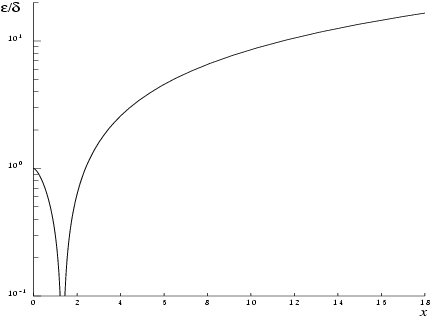NAG Library Routine Document
s18arf (bessel_k1_real_vector)
1
Purpose
s18arf returns an array of values of the modified Bessel function .
2
Specification
Fortran Interface
| Integer, Intent (In) | :: | n | | Integer, Intent (Inout) | :: | ifail | | Integer, Intent (Out) | :: | ivalid(n) | | Real (Kind=nag_wp), Intent (In) | :: | x(n) | | Real (Kind=nag_wp), Intent (Out) | :: | f(n) |
|
C Header Interface
|
#include <nagmk26.h>
| void |
s18arf_ (const Integer *n, const double x[], double f[], Integer ivalid[], Integer *ifail) |
|
3
Description
s18arf evaluates an approximation to the modified Bessel function of the second kind for an array of arguments , for .
Note: is undefined for and the routine will fail for such arguments.
The routine is based on five Chebyshev expansions:
For
,
For
,
For
,
For
,
For
near zero,
. This approximation is used when
is sufficiently small for the result to be correct to
machine precision. For very small
it is impossible to calculate
without overflow and the routine must fail.
For large , where there is a danger of underflow due to the smallness of , the result is set exactly to zero.
4
References
5
Arguments
- 1: – IntegerInput
-
On entry: , the number of points.
Constraint:
.
- 2: – Real (Kind=nag_wp) arrayInput
-
On entry: the argument of the function, for .
Constraint:
, for .
- 3: – Real (Kind=nag_wp) arrayOutput
-
On exit: , the function values.
- 4: – Integer arrayOutput
-
On exit:
contains the error code for
, for
.
- No error.
- , is undefined. contains .
- is too small, there is a danger of overflow. contains zero. The threshold value is the same as for in s18adf, as defined in the Users' Note for your implementation.
- 5: – IntegerInput/Output
-
On entry:
ifail must be set to
,
. If you are unfamiliar with this argument you should refer to
Section 3.4 in How to Use the NAG Library and its Documentation for details.
For environments where it might be inappropriate to halt program execution when an error is detected, the value
is recommended. If the output of error messages is undesirable, then the value
is recommended. Otherwise, if you are not familiar with this argument, the recommended value is
.
When the value is used it is essential to test the value of ifail on exit.
On exit:
unless the routine detects an error or a warning has been flagged (see
Section 6).
6
Error Indicators and Warnings
If on entry
or
, explanatory error messages are output on the current error message unit (as defined by
x04aaf).
Errors or warnings detected by the routine:
-
On entry, at least one value of
x was invalid.
Check
ivalid for more information.
-
On entry, .
Constraint: .
An unexpected error has been triggered by this routine. Please
contact
NAG.
See
Section 3.9 in How to Use the NAG Library and its Documentation for further information.
Your licence key may have expired or may not have been installed correctly.
See
Section 3.8 in How to Use the NAG Library and its Documentation for further information.
Dynamic memory allocation failed.
See
Section 3.7 in How to Use the NAG Library and its Documentation for further information.
7
Accuracy
Let and be the relative errors in the argument and result respectively.
If
is somewhat larger than the
machine precision (i.e., if
is due to data errors etc.), then
and
are approximately related by:
Figure 1 shows the behaviour of the error amplification factor
However, if is of the same order as the machine precision, then rounding errors could make slightly larger than the above relation predicts.
For small , and there is no amplification of errors.
For large , and we have strong amplification of the relative error. Eventually , which is asymptotically given by , becomes so small that it cannot be calculated without underflow and hence the routine will return zero. Note that for large the errors will be dominated by those of the standard function exp.
8
Parallelism and Performance
s18arf is not threaded in any implementation.
None.
10
Example
This example reads values of
x from a file, evaluates the function at each value of
and prints the results.
10.1
Program Text
Program Text (s18arfe.f90)
10.2
Program Data
Program Data (s18arfe.d)
10.3
Program Results
Program Results (s18arfe.r)

